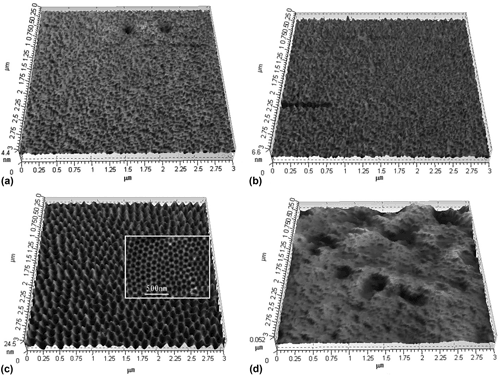Crossref Citations
This article has been cited by the following publications. This list is generated based on data provided by
Crossref.
Zhan, Wei-ting
Ni, Hong-wei
Chen, Rong-sheng
Yue, Gao
Tai, Jun-kai
and
Wang, Zi-yang
2013.
Photocatalytic activity of ferric oxide/titanium dioxide nanocomposite films on stainless steel fabricated by anodization and ion implantation.
International Journal of Minerals, Metallurgy, and Materials,
Vol. 20,
Issue. 8,
p.
725.
Zhan, W.T.
Ni, H.W.
Chen, R.S.
Wang, Z.Y.
Li, Y.W
and
Li, J.H.
2013.
One-step hydrothermal preparation of TiO2/WO3 nanocomposite films on anodized stainless steel for photocatalytic degradation of organic pollutants.
Thin Solid Films,
Vol. 548,
Issue. ,
p.
299.
Rezaei, Behzad
Havakeshian, Elaheh
and
Ensafi, Ali A.
2014.
Fabrication of a porous Pd film on nanoporous stainless steel using galvanic replacement as a novel electrocatalyst/electrode design for glycerol oxidation.
Electrochimica Acta,
Vol. 136,
Issue. ,
p.
89.
Lu, W.
Zou, D.
Han, Y.
Liu, R.
and
Tian, C.
2014.
Self-organised nanoporous anodic films on superaustenitic stainless steel.
Materials Research Innovations,
Vol. 18,
Issue. sup4,
p.
S4-747.
Ni, Siyu
Sun, Linlin
Ercan, Batur
Liu, Luting
Ziemer, Katherine
and
Webster, Thomas J.
2014.
A mechanism for the enhanced attachment and proliferation of fibroblasts on anodized 316L stainless steel with nano‐pit arrays.
Journal of Biomedical Materials Research Part B: Applied Biomaterials,
Vol. 102,
Issue. 6,
p.
1297.
Wang, Ziyang
Ni, Hongwei
Chen, Rongsheng
Zhan, Weiting
Zhang, Chao
Lei, Rui
and
Zhang, Bowei
2014.
Enhanced performance of multilayer graphene platelet film via three dimensional configuration with efficient exposure of graphitic edge planes.
Electrochemistry Communications,
Vol. 47,
Issue. ,
p.
75.
Rezaei, Behzad
Havakeshian, Elaheh
and
Ensafi, Ali A.
2015.
Decoration of nanoporous stainless steel with nanostructured gold via galvanic replacement reaction and its application for electrochemical determination of dopamine.
Sensors and Actuators B: Chemical,
Vol. 213,
Issue. ,
p.
484.
Sagu, Jagdeep S.
Wijayantha, K. G. Upul
Bohm, Mallika
Bohm, Siva
and
Kumar Rout, Tapan
2016.
Anodized Steel Electrodes for Supercapacitors.
ACS Applied Materials & Interfaces,
Vol. 8,
Issue. 9,
p.
6277.
Luo, Song
Zheng, Qiongbin
Jie, Xiaohua
and
Zhang, Liuyan
2016.
Fabrication of a micro-nano structure on steel surface and surface wetting.
RSC Advances,
Vol. 6,
Issue. 53,
p.
47588.
Luo, Song
Jie, Xiaohua
Zheng, Qiongbin
Zhang, Liuyan
Wu, Huishu
and
Huang, Xiaoye
2017.
Preparation of an Anodized Shot-Peened Layer on Steel and Its Controllable Wettability.
Transactions of the Indian Institute of Metals,
Vol. 70,
Issue. 8,
p.
2175.
Pawlik, Anna
Hnida, Katarzyna
Socha, Robert P.
Wiercigroch, Ewelina
Małek, Kamilla
and
Sulka, Grzegorz D.
2017.
Effects of anodizing conditions and annealing temperature on the morphology and crystalline structure of anodic oxide layers grown on iron.
Applied Surface Science,
Vol. 426,
Issue. ,
p.
1084.
Prasad, Mooni Siva
Chen, Rongsheng
Li, Yang
Rekha, Dasari
Li, Dan
Ni, Hongwei
and
Sreedhar, Neelam Yugandhar
2018.
Polypyrrole Supported With Copper Nanoparticles Modified Alkali Anodized Steel Electrode for Probing of Glucose in Real Samples.
IEEE Sensors Journal,
Vol. 18,
Issue. 13,
p.
5203.
Rezaei, Behzad
Mokhtarianpour, Maryam
and
Ensafi, Ali Asghar
2018.
Hydrogen evolution reaction and formic acid oxidation by decorated nanostructural Pt/Pd on a copper-filled nanoporous stainless steel.
Journal of the Iranian Chemical Society,
Vol. 15,
Issue. 4,
p.
955.
Cui, Yuehua
Paxson, Adam T.
Zhang, Xianghua
Tu, Qiang
and
Varanasi, Kripa K.
2019.
Study of the relationship between the crystal structure and micro-nano morphology of anodized stainless steels.
Electrochemistry Communications,
Vol. 101,
Issue. ,
p.
109.
Wang, Hefeng
Zhang, Jiaojiao
and
Jin, Xiaomin
2020.
Effects of Anodization-Assisted Electrodeposition Conditions on the Fabrication of CuO-Cu2O Coatings on Nanoporous Stainless Steel.
Advances in Materials Science and Engineering,
Vol. 2020,
Issue. ,
p.
1.
Lee, Hanuk
and
Park, Jae-Woo
2020.
Titanium-doped stainless steel nanotubes for the photocatalytic degradation of an organic compound.
Catalysis Today,
Vol. 340,
Issue. ,
p.
268.
Wang, Yuanlong
Guo, Rongsheng
Zhou, Xiong
and
Hu, Guanghong
2020.
Experimental investigation on optimal anodising parameters of nanopore preparation process on the stainless steel surface.
Corrosion Engineering, Science and Technology,
Vol. 55,
Issue. 7,
p.
513.
Wang, Yingge
Li, Gang
Wang, Kaiying
and
Chen, Xuyuan
2020.
Fabrication and formation mechanisms of ultra-thick porous anodic oxides film with controllable morphology on type-304 stainless steel.
Applied Surface Science,
Vol. 505,
Issue. ,
p.
144497.
Wen, Li
Wanpei, Hu
Qian, Liu
Xu, Liang
Rongsheng, Chen
Hongwei, Ni
and
Weiting, Zhan
2020.
Antibacterial properties of Ag/TiO2/PDA nanofilm on anodized 316L stainless steel substrate under illumination by a normal flashlight.
Journal of Materials Science,
Vol. 55,
Issue. 22,
p.
9538.
Amouzadeh Tabrizi, Mahmoud
Ferre-Borrull, Josep
and
Marsal, Lluis F.
2020.
Advances in Optical Biosensors and Sensors Using Nanoporous Anodic Alumina.
Sensors,
Vol. 20,
Issue. 18,
p.
5068.





